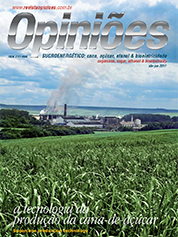Ismael Perina Junior
President of Orplana
Op-AA-28
To unite will be the determinant survival factor for small producers
In recent years, the sugar-based industry enjoyed spectacular growth, in the magnitude of ten percent per year, was reason for envy of all other industries, and brought enormous momentum to regions in which this development is taking place. The figures are impressive, given that we practically doubled our sugarcane production in the last ten years.
This growth allowed generating a large number of direct and indirect jobs in the production centers and neighboring cities, which witnessed the implementation of small industrial businesses and the strengthening of local trade activities. People’s quality of life undoubtedly also improved considerably, given that income increased.
Much of this growth was brought about by legions of rural producers that saw in this activity means to improve development, whether at the professional or personal level. The sugarcane producer class has some peculiar characteristics, and the most interesting might possibly be the large number of small producers that, even today, make their living from this activity.
When one thinks of the sugar-based energy industry, of the gigantism it represents, and its exposure in the media, one would tend to imagine a scenario in which there is no room for small producers, and sugarcane production is only the result of activities of mills or large rural producers. Absolutely wrong. Looking at Orplana data, approximately 90% of farmers individually produce less than 12,000 tons of sugarcane.
This universe of people, which for the most part have worked in this activity for many years, represents small companies, in which the work is done by their own family members. In addition, direct and indirect jobs are generated in sufficiently large numbers, which drive the economy in many regions. Furthermore, it is well-known that these people drive local trade, allowing better distribution of income and diminishing possible migration to cities or to large urban centers.
With this new no-burning sugarcane production scenario, these producers must be alert if they want to continue producing. It is important to point out that conditions in agriculture have changed, difficulties have increased, and costs go up with every new cycle. Professional management will be determinant for their remaining in this business.
Thus, a change in attitude is called for. In a recent past, small sugarcane areas could easily be harvested. The producer did the burning and the manual cutting. Now, in times of green sugarcane harvesting, larger and more uniform plots of land are required. The lots must be bigger, and this is true for the neighbors who also have to adapt to this same situation.
There fore, to organize in groups is absolutely mandatory and will facilitate developing the activity and, more importantly, the harvesting. In the past, it was quite common for various producers to organize themselves in consortia, facilitating the harvesting and the planting. Now, the time has come for producers to prepare for this new situation.
Another aspect I see as reason for concern is the concentration process affecting the mills. This phenomenon is occurring right before our eyes, at impressive speed. Forming producer groups may influence another important aspect, i.e., the sales process. No doubt pressure to negotiate will increase and one will no longer deal with the mill owner, as has been the case for many until now.
We will negotiate with their representatives, that often a time may be replaced from one harvest to the next. Thus, the relationship history will cease to have the weight it used to have, with focus shifting towards a more professional negotiation. Negotiation groups may represent some gain for producers, who increasingly face more problems related to the end result of their activity.
So, what do we have? If we get organized to work together, we will greatly contribute to decreasing costs, nowadays an essential factor to be considered, which will allow us to increase our income and, on the other hand, if this getting together shall allow us to negotiate better, we shall achieve better results. We are obliged to pursue this new type of attitude.
Irrespective of the above, when looking at the mills in a broader manner, we will notice that we need to be more actively engaged in our representative entities, strengthening them. Our sugarcane producer associations and cooperatives will undoubtedly continue supporting the producers, and they will be the institutions that will continue assisting producers in developing their sugarcane activity. History has already shown what important role these institutions play in the country’s production regions.




